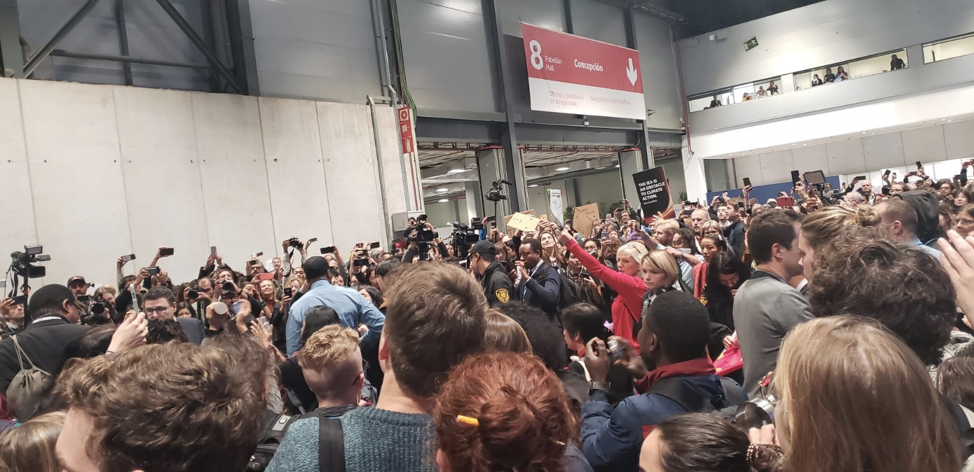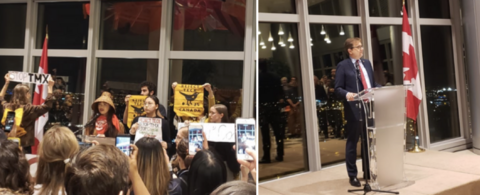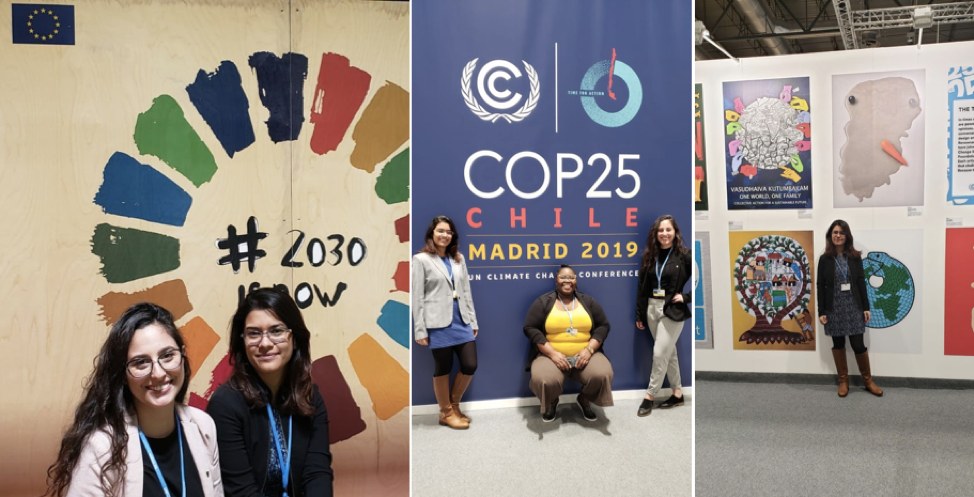We're aware of the issue, but we're missing the increased ambition to fight climate change together
Three days of attending the COP25 made me realize how far we have come on this path to combat Climate Change. But it is Not Enough!! is what I gathered from attending various events and discussions at the COP. Being here as a Waterloo graduate student is a lifetime opportunity as this event exposed me to the real global picture about the climate change crisis. During my short time here, I got a chance to listen to people from all across the globe, and they shared their stories on how their communities are suffering because of Climate Injustice, and how their leaders are lagging behind in taking some serious steps towards climate change.

Conference of the Parties or the COP is organized every year by UNFCCC to bring the world leaders together and negotiate the climate related targets. The 25th COP focuses on ensuring that all the counties implement their Paris agreement targets by 2020 and become carbon neutral by 2050. This goal is mainly to stick to the 1.5 degrees global temperature rise. This seems a lot to achieve considering UN is organizing its 25th COP and countries are still negotiating and only talking about what is to be done on oppose to discussing challenges and solutions. As an observer at the COP, I witnessed two very different sides of this event, one from global leaders’ perspective who are very optimistic towards achieving their Paris Targets and second, from climate activists’ and youths’ perspective, who showed their extreme anger by protesting and demanding Climate Justice and instant actions.
One of the biggest protests, I witnessed at the COP25 on my third day, happened outside the High-level event on Climate Action, where on one hand Mary McAleese (Ex-President of Ireland, one of the panelists) asked people to get Angry! and get Active! while on the other hand about 200 activists/ protesters were de-badged from the whole conference.

Indigenous People Protesting (left); Minister Wilkinson making an address at the Canada's Reception (right).
Canada’s Minister Jonathan Wilkinson at the reception dinner assured that Canada is on right path and that the country will exceed its Paris Target by 2030 and will become Carbon Neutral by 2050. While people again asking questions and raising their voices about nothing being done for indigenous communities and Canada’s investment on pipelines. As an observer I witnessed multiple instances where contrary comments were being made and actions were taken by the leaders, and people attempting to question them every time.
So far, COP25 has been very interesting experience and an eye opener for me. It makes me feel sad about the current leadership and political situations, but also makes me feel proud that us millennials are aware of the climate crisis and are actively working towards it. Gretta Thunberg, in her speech rightly said that “there is a hope, but it will not come from the government or corporations, it will come from the people”.
As a planning student, I have attended about six official side events and some of the Green Zone (open to public) events, aligning with my research focus. It was very informative to listen to the researchers and activists talking about new concepts and initiatives being taken all across the world to combat climate change, including carbon pricing/ carbon-tax, private partnerships and engagements, gender responsive climate actions and building resilient communities. Lot of these discussions were focus on Climate Justice and need to scale up the actions towards communities which are poor and most vulnerable to climate change. I am very excited for my last days at COP and looking forward to interacting with more people and gather as much insights and information as I can.
Concluding thoughts
This year’s COP had a difficult start with Brazil backing out last year, Chilean government also decided not to host the event due to the country’s difficult circumstances. Considering the current climate crisis and urgent need of hosting this event on the said dates, Spain stepped in and decided to take on the event in Madrid. Despite of the change of venue at the last minute, the event was organized in similar fashion to what was decided. The whole event venue was divided in to two zones – the Green Zone (open to public) and the Blue Zone. The green zone had various events and workshops with a sole agenda to make community more aware about the climate change and its consequences and to showcase how individuals can contribute towards this fight. Blue Zone was more formally structured, and all the negotiations and official side-events were happening in the area. The Blue-Zone was restricted to only the parties and the observers.
The main events and negotiations of this year’s COP were mainly focused on finalizing the terms of Article-6 of the Paris Agreement by setting some rules for global carbon market. Article-6 promotes “Climate Justice" by putting a price on carbon emissions, in other words, it suggests that the countries which are responsible for emissions must bear the cost of global warming. However, as an observer at COP, I understood that the countries responsible for large scale emissions are the ones who can impact decision making. The one of the reasons, why this year’s talk was unable to reach the consensus and why decisions were pushed to the next year. Many leaders including UN Secretary General said during the conclusion meeting that COP25 was disappointing as the countries failed to showcase their increased ambitions to tackle climate change. Young activist Gretta Thunberg said in her final speech that the annual COPs are truing into opportunities for countries to negotiate loopholes. Listening to these world leaders and young activists, made me realize that counties are far behind from even showing their ambitions towards climate change fight which is supposedly the first and foremost step. Without this ambition, it would be extremely difficult to achieve the goal of allowing 1.5 degree of global temperature rise by 2030.
My experience and key learnings
As a transport planner, I followed various events related to my research which is about reducing emissions in transport (especially urban freight sector) in Canadian context. The most relevant event I attended was on “Sub-national efforts to Reduce Transport Emissions in North America”. Panellists from various states of US (Minnesota, California and Hawaii) and Canada (Quebec) presented their best practices and current policies in place.
However, the discussion was mainly focused on reducing emissions in passenger transport mainly by providing public transport and promoting active transport. Focusing only on passenger transport was not at all surprising for me as through my research I already knew that freight is often overlooked especially in North America. However, with increased demand of e-commerce and rising emissions in this sector, I was expecting more events focusing on freight. Another interesting viewpoint, I got from an organisation called “Sail to COP”. About 20 representatives from this organisation were protesting to include international aviation sector in the carbon market. Aviation is one of the biggest emitters of greenhouse gases and currently not included in carbon tax system or usually not talked about in these COP negotiations. Some of the other interesting events I attended and briefing of these events are presented below:
- Impact of Climate Change on Job market; this event highlighted some shocking facts and forecasts about the economic impact. One of the panellists highlighted that by 2030, world will lose 2.2% of its total working time (~18 million jobs) to climate change.
- Gender Responsive Climate Actions; this event was presented by women activists from all across the globe. This event highlighted that due to security and safety reasons women tend to emit more emissions than men and that there is a need to link women safety with climate change.
- Community Resilience Partnership Program by Asian Development Bank; in this event ADB highlighted the need to increase participation of local communities in climate action. In this event ADB also committed that in next 10 years the focus of their investment ($80 million) will be towards climate change mitigation and adaptation in Asian & Pacific counties which will target poor and vulnerable people.
- Fashion Industry for Climate Change Charter, from COP24 to COP25; this event highlighted interesting facts about fast fashion business models and how they promote over consumerism and over consumption.
Attending these side events gave me the impression that global researchers and policy makers are well aware of the scientific facts and the forecasts of climate change impacts. However, I found various gaps in most of these discussions in terms of implementation strategies and laying out strict timelines.
Key takeaway

I am an immigrant from India, which has a huge coastline, diverse geography and vast population. I am worried about the impact my country and several others in the similar situation, might face due to climate change and sea level-rise. I am also a travel and have just started to explore parts of the world, I am worried that I might not get to experience this beautiful world. During my time at COP25, I witnessed two very different sides of the event, one from global leaders’ perspective who are optimistic and are working on their own pace, second, from younger generation’s perspective, who are scared and disappointed and are demanding Climate Action and Climate Justice Now. Seeing all the efforts from the organizers, researcher, activities and young protesters, made one thing very clear to me that globally we more aware of the issue, the only thing missing is our increased ambition to fight climate change together.

Isha Rana is a master’s student at the School of Planning. She attended COP25 United Nations Climate Change Conference in Madrid, Spain during fall 2019. This is her reflection from participating as a student delegate.